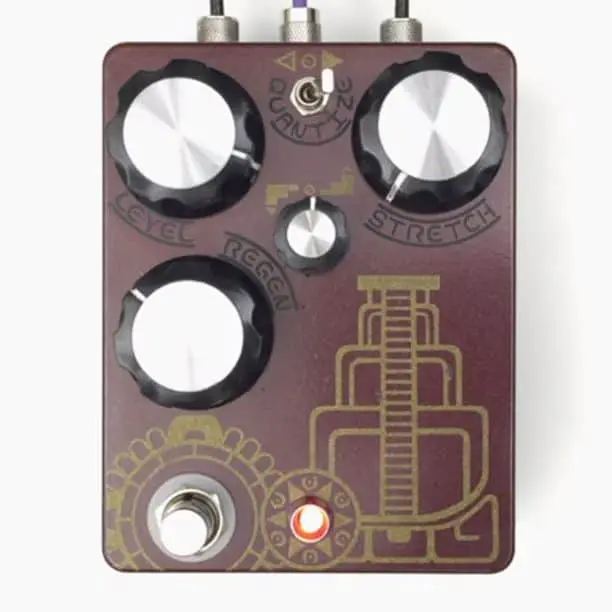
Hungry Robot never ceases to surprise us with their lush, imaginative designs.
They just unveiled a new “Arpeggiating Reverb” called El Castillo.
For those looking to get experimental with their time-based effects, the Hungry Robot El Castillo combines delay, reverb, and pitch-shifting into one fairly compact unit. The pedal is based on 2 modes, determining how the Pitch knob functions. Quantize mode keeps the pitch-shifting locked into +1 and -1 octaves with the ability to blend between them or use them separately. The other setting gives access to much more experimental side of the pedal via a range of pitch intervals.
It can do everything from fairly normal reverb and delay sounds, as well as shimmer. There is an arpeggiator function that can be as beautiful or as haunting as you want. – Brandon Stoner
—
SECTIONS:
(0:00) Basic Controls with Guitar
(1:09) Quantizing with Guitar
(3:00) Delay Stretch with Synth
(4:40) Video Games with Pocket Operator
GEAR:
PRS Hollowbody II
Minilogue
Pocket Operator
Apogee Duet
3 Monkeys Solderless
Lots of videos of the Catillo are coming out already, here’s three:
El Castillo is an arpeggiating reverb that takes pitch-bent reverb to an entirely new level. It uses a unique combination of 3 circuit blocks (reverb, pitch-shift, and delay) to create a highly experimental, ambient reverb.
REVERB – The reverb block is the heart of the pedal. It uses the same high quality reverb brick found in my other reverb pedals. It has two controls: “Level” and “Regen.” The “Level” control increases the amount of wet signal, without effecting the dry signal. The “Regen” control controls the amount of signal fed through the feedback loop. Turing up the “Regen” knob will increase the decay and also the number or arpeggiations.
PITCH-SHIFT – The pitch-shift block is located in the feedback loop of the reverb. Adding a pitch-shift to the feedback signal creates a “stair step” effect. Each time the signal travels through the feedback loop, it will shift the pitch of the wet signal up or down. The pitch shifting section is controlled by the “Quantize” mode switch and the “Pitch Knob” (small, middle knob). More info below about the mode switch
DELAY – The delay block is also located inside the feedback loop. It is a simple, single repeat delay that can range from 0-800ms. This feature causes the signal to delay going through the pitch-shift block. With the delay time set at minimum, the stair stepping effect happens very quickly. As you increase the delay time, the pitch intervals are stretched out and it creates a very gradual pitch arpeggiation. The delay length is determined by the “Stretch” knob.
MODES – El Castillo has 2 modes of operation: Un-Quantized and Quantized. The toggle switch selects the mode and determines the function of the “Pitch” knob.
In the “Un-Quantized” mode (toggle to the left), the pitch knob has a free-range and can select any pitch interval between -1 octave and +1 octave. At 12 o’clock, there is zero pitch-shift.
In the “Quantized” mode (toggle to the right), the pitch-shift is locked to -1 octave and +1 Octave. Turning the pitch knob crossfades between the two octave shifts to allow both to be heard at once or separately. Turning the knob fully to the left provides only octave down intervals. Turning the knob to the right provides only octave up intervals (traditional shimmer). At 12 o’clock, there is a 50/50 blend of octave up and octave down intervals.






















